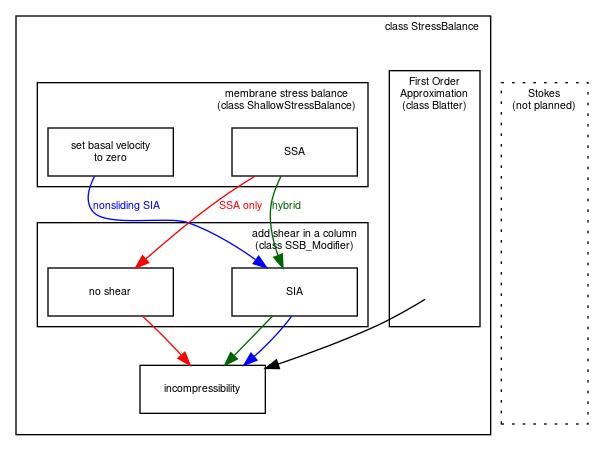A hierarchy of simplifying assumptions for grounded ice flow¶
Table 4 describes a hierarchy of models, listed roughly in order of increasing effectiveness in modeling grounded ice sheets with fast flow features. This is also the order of increasing need for data to serve as boundary and initial conditions, however, as also described in the Table.
Model |
Assumptions |
Required data |
|---|---|---|
perfectly-plastic ice |
steady state; ice has shear stresses below a pre-determined ice “yield stress”; also needs pre-determined location of ice sheet margin |
|
balance velocities |
steady state; ice flows down surface gradient [57] |
same as above, plus:
|
isothermal SIA |
same as above, but time-dependence is allowed |
|
thermo-coupled SIA |
non-sliding lubrication flow, temperature-dependent softness [16], [12] |
same as above, plus:
|
polythermal SIA |
allows liquid water fraction in temperate ice; conserves energy better [22], [44] |
same as above |
SIA + SSA hybrid |
SSA as a sliding law for thermo-coupled SIA [10], [17]; polythermal by default |
same as above, plus:
|
First Order Approximation |
pressure within the ice is hydrostatic; \(x\) and \(y\) derivatives of the vertical velocity component are small compared to \(z\) derivatives of horizontal components [41], [42], [60] |
same as above |
It may also be helpful to view the implemented stress balances as PISM software components (C++ classes). Fig. 14 shows the sequences of actions taken by the SIA-only, SSA-only, and SIA+SSA hybrid model components. In each case a membrane stress solution is generated first, then a distribution of vertical shear in the column of ice is generated second, and finally a use of incompressibility computes the vertical component of the velocity. The nonsliding SIA-only model has a trivialized membrane stress solution. The SSA-only model has a trivialized computation of vertical shear.

Fig. 14 The SIA-only, SSA-only, and SIA+SSA hybrid models represent different “routes” through stress balance PISM components. In each case the inputs are ice geometry and boundary stresses, and the final output is a three-dimensional velocity field within the ice.¶
| Previous | Up | Next |
